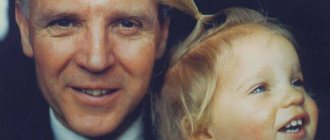Personality is a complex and multifaceted phenomenon, therefore modern psychology cannot yet develop an accurate and generally accepted definition of this concept. A huge variety of theories and concepts describing the nature and mechanisms of personality development have been united by researchers into basic theories of personality. In psychology, several theories of personality are actively being developed, among which five are recognized as the most significant: phenomenological, dispositional, behavioral, cognitive and psychodynamic.
Phenomenological theory of personality
In line with the phenomenological direction, the idea is emphasized that personal behavior can be characterized only in the terminology of its subjective perception and comprehension of reality. That is, this approach is based on the assertion that objectively existing reality is a reality that is consciously perceived and interpreted by a person at a certain point in time. Another equally important thesis of the phenomenological approach is the denial of fatalism, that is, the assertion that a person can build his own destiny, he has a choice in making decisions regarding his own life and the lives of others. However, a person must accept responsibility for the actions taken. The third position of the phenomenological approach is the recognition by its supporters of the positive nature of man and his desire for self-development and self-improvement.
Are you an expert in this subject area? We invite you to become the author of the Directory Working Conditions
A consistent interpretation of the phenomenological approach is presented in the works of the American psychologist C. Rogers, according to whom a person is a positive and reasonable creature who sincerely wants to live in harmony with himself and others. The driving force behind personal development, according to Rogers, is the desire for actualization, that is, the desire to preserve and develop oneself, showing the best qualities inherent in nature.
What motives were based on the incentive schemes proposed by behavioral theory [p.490]
Personnel planning 443-445 Behavioral theories 13 Company positioning 279-283, 368 Powers 26, 85-86, 488-490 Needs 482-487 Legal approach 13 Entrepreneurship 25, 65—67, 116, [p.582]
At the same time, many publications are difficult to attribute to any one direction. Modern research in the theory of industrial organization freely combines empirical facts, models using a variety of mathematical methods (limit analysis, probability theory, game theory, regression analysis), behavioral theories, organizational theories, as well as descriptive models related to both neoclassical and to the institutional direction (the theory of transaction costs). [p.279]
Behavioral Theory of the Firm - Mellon University School - Carnegie [p.647]
Behavioral theory of consumption - Michigan School [p.651]
Behavioral theory of the company - [p.782]
Behavioral theory of consumption - Michigan School…………651 [p.782]
An attempt to understand the true reasons for decision-making led to the emergence of descriptive models based on the behavioral theory of decision-making (second approach). It is clearly explanatory (how decisions are actually made) rather than prescriptive (what decisions should be) in nature. It uses psychological models that take into account the processes and forces that explain the actual behavior of decision makers. [p.5]
An example of a descriptive model based on behavioral decision theory is the equity model. [p.6]
BEHAVIORAL THEORY OF THE FIRM - a view of the nature of companies as complex organizations that solve problems of conflict of goals and communications. [p.288]
Behavioral theory attaches great importance to subjective factors, including experience, logic, and intuition of the subject of management. [p.51]
BEHAVIORAL THEORIES OF LEADERSHIP [p.172]
If theories of leadership personal qualities emphasized the need to recognize and select future leaders based on identifying relevant personal qualities and characteristics, then behavioral theories of leadership contributed to increased attention to issues of training effective forms of management. [p.172]
The main conclusion of representatives of behavioral theories of leadership was the following: behavior focused on the successful solution of production problems, while simultaneously creating job satisfaction among subordinates and their development, is usually accompanied by higher performance indicators, discipline and low staff turnover compared to those departments that led by leaders who ignore these issues. Thus, the organization's task is not only to recognize an effective leader in the personnel selection process, but also to train him in the skills of successful people management. [p.173]
At the same time, the interest in behavioral theories of leadership that arose in the 40s and 50s. XX century, began to decline in the early 60s, since these theories did not take into account a number of other important factors that determine the effectiveness of management activities in a given production situation. [p.173]
F. Fiedler, in contrast to representatives of the theory of personal qualities of a leader and behavioral theories of leadership, suggested that the effectiveness of the group will depend on the following factors: 1) how much the chosen management style takes into account the characteristics of subordinates 2) what opportunities the leader has to influence their behavior. After studying leader behavior and effectiveness in various situations, Fiedler came to the conclusion that an effective leader must alternately demonstrate different leadership styles (depending on the specific situation). In some cases, priorities should be given directly to solving production problems (for example, technical support for production, [p.173]
Modern (behavioural) management theory appeared at the beginning of the 20th century. and is based on behavioral positions closer to the work situation [p.580]
If, when assessing the implementation of estimates, an approach based on modern (behavioral) management theory is used, then this assumes a wider participation of workers in motivating their work than with the traditional approach. The result of this increased participation should be improved employee relations within the enterprise. [p.580]
In this chapter we attempt to provide a general overview of research conducted using prescriptive and descriptive approaches. We first look at the assumptions underlying decision-making techniques, such as the present value analysis found in typical business plans. We then move on to the normative model that many accounting researchers still use today. Next, we will discuss the issue from the perspective of behavioral accounting theory, examining how people actually make decisions. The logic of the presentation will lead us to an ethical approach, and we will discuss which decision can be considered correct and objective. [p.130]
Behavioral theories that consider the problem from the perspective of the behavior of a manager seeking to effectively organize the activities of his subordinate employees. [p.108]
Behavioral theories of leadership style There are one-dimensional and two-dimensional interpretations of leader behavioral styles. [p.108]
BEHAVIORAL THEORIES OF THE FIRM - theories that view the firm as a coalition of subgroups whose tasks do not initially coincide. [p.656]
However, from the position of behavioral theory, resistance is a natural manifestation of various concepts of reason, according to which groups and individuals [p.367]
Moreover, in promoting the marketing management model as a new approach, its advocates have been guilty of ignoring or overlooking the roots, or foundations, of marketing, which should have been originally identified in the works of nineteenth-century political economists. (This view belongs to the author of this article and not to the authors of the cited sources. In my opinion, political economy was and is a behavioral theory of production, consumption and exchange, it only recently began to use quantitative methods - perhaps in the pursuit of unattainable scientific precision, which disguised and distorted this fact. Beware, marketer) It is obvious that there is little new in the marketing management model, as the progress of the 1960s clearly demonstrates. [p.1145]
Behavioral theory of capital structure [p.222]
Chapter 12. Behavioral theory of capital structure 223 [p.223]
In the 1970s and 80s, management modeling using computer technology became a mandatory component of any serious management program in the USA and Europe. At the same time, there is a renaissance of interest in software disciplines. During this period, behavioral theories X/Y (D. McGregor) and theories Z (W. Ouchi), theories of behavior change (B. Skinner) and theories of group problem solving (K. Lewin) became famous. P. Drucker brings his management principles to the attention of specialists. Set of qualities of a manager [p.13]
What is the essence of the method of summing ranks as a way to select alternatives for group management 8. Characteristics of models of the behavioral theory of management decisions. 9- What is the technology for computer discussion of group decisions [p.92]
Q General characteristics Q Model of bounded rationality - the methodological basis of behavioral theory G Models of variable rationality Q Behavioral theory of the firm - Mellon-Carpegi University School G Behavioral theory of consumption - Michigan School [p.639]
Let us also note that adherents of behavioral theory set themselves not only descriptive, but also normative tasks. Having explained the approximate algorithms for solving problems that are used by participants in the experiment or interviewed real participants in economic activity, they build computer programs based on them, and then hold a tournament between these Go programs to identify the best strategy. [p.641]
In behavioral theory, the firm was treated as an association of groups pursuing their own goals. They participate in a political process that results in a social compromise—bargain. In O. Williamson’s model of independent behavior, decisions are made by the leading group, which [p.73]
Dispositional theory of personality
Dispositional personality theory is often characterized as a trait theory, which is associated with the main statement of this direction: a person has certain predispositions (dispositions) to specific reactions in various situations. These dispositions were called personality traits by direction theorists. In other words, a person demonstrates consistency in thoughts and actions, which is not influenced by either circumstances or the person’s previous experiences. In accordance with this, each personality is unique; its description is possible by characterizing its traits. Representatives of dispositional theory are Gordon Allport, Hans Eysenck and Raymond Cattell.
Finished works on a similar topic
Coursework Theories of personality. Theory of C. G. Jung 480 ₽ Abstract Theories of personality. Theory of C. G. Jung 250 ₽ Test Theories of Personality. Theory of C. G. Jung 200 ₽
Receive completed work or specialist advice on your educational project Find out the cost
Behavioral theories of personality
Sometimes this direction is called learning theory. The main thesis of behavioral theories boils down to the following: a person is the experience that she has acquired in life, what she has learned. The main source of personality development is the environment (in a broad sense), and the main elements of personality include reflexes and socialization skills. Behavioral theories of personality can be considered from the point of view of two directions. The first includes the works of famous American psychologists J. Watson and B. Skinner, who outlined one of the key ideas of classical behaviorism: human behavior is influenced by external circumstances and can be described by the formula: S → R. From the point of view of supporters of the second direction (A. Bandura and J. Rotter), the regulation of human behavior is carried out not so much by external environmental factors as by internal characteristics and ideas of the individual (goal, expectation, self-perception, etc.).
Cognitive theories of personality
This approach was actively developed in the works of the American psychologist J. Kelly, who believed that a person is like a researcher trying to understand what is happening to him, and based on this, predict what will happen in the future. That is why cognitive and intellectual processes have such a significant impact on a person’s behavior. J. Kelly argued that the world is perceived and interpreted by a person with the help of specific models, which the scientist proposed to call constructs. With this consideration, personality is a complexly organized system of the most important constructs, which reflect the feelings of the individual and its interpretation of previous experience. Therefore, relationships such as friendship and love are possible only between people who have similar constructs.
PERSONALITY STRUCTURE AND DIFFERENT APPROACHES TO ITS DEFINITION
Currently, a number of approaches to understanding personality have emerged: 1) biological; 2) sociological; 3) individual psychological; 4) socio-psychological, etc.
From the point of view of the biological approach, personality development represents the unfolding of a genetic program.
From the point of view of the sociological approach, personality is a product of cultural and historical development.
From the point of view of the individual psychological approach, personality development is influenced by such features as human constitution, type of nervous system, etc.
Social-psychological approach
to understanding personality
explains the mechanisms of personality socialization;
reveals its socio-psychological structure; allows you to diagnose this structure of personality characteristics and influence it. Personality structure
(according to
K.K. Platonov)
consists of four substructures:
1) A substructure of the orientation and relationships of a person, including the drives, desires, interests, inclinations, ideals, views, beliefs of a person, his worldview.
The substructure of personality orientation is the most socially conditioned, formed under the influence of upbringing in society, and most fully reflects the ideology of the community in which the person is included.
2) Individual social experience of a person, which includes the knowledge, skills, abilities and habits acquired by a person.
This substructure is formed primarily during the learning process and is of a social nature.
3) Individual characteristics of human mental processes, i.e. individual manifestations of memory, perception, sensations, thinking, abilities,
depending both on congenital factors and on training, development, and improvement of these qualities.
4) Biologically determined substructure, which includes typological, age, gender properties of the individual, i.e. biopsychic.
According to Platonov, these substructures differ in the weight of their social and biological contents, and in the choice of these substructures as the subject of analysis, general psychology differs from social psychology. General psychology focuses on three substructures: biological
(gender, temperament),
psychological
(memory, emotions, thinking),
social experience
(knowledge, skills, abilities, habits) the fourth share of social psychology remains under the name of
orientation
(beliefs, worldview, personal meanings, interests).
Sukhov and A.A. Derkach note that the socio-psychological structure of personality
includes: mentality, value-semantic sphere, motivational sphere (direction, goals, plans, life path), cognitive characteristics (pictures of the world); “I”-characteristics” (“I”-conception.”, self-attitude, self-esteem); locus of control; socio-psychological competence of the individual; status-role characteristics of the individual; emotional mental states, emotions and feelings of the individual, consider some of these characteristics.
Psychodynamic theories of personality
The starting points of the psychodynamic theory of personality were presented by S. Freud within the framework of the theory of “classical psychoanalysis” he developed. From the point of view of S. Freud, the key driving factor in personality development are innate instincts, which can be grouped into two main groups: life instincts (Eros) and death instincts (Thanatos). The researcher considered sexual instincts, the energy of which he called “libido,” to be no less significant for the development of personality. Later, the term "libido" was used by Freud to describe the energy of all life instincts. S. Freud also proposed three main personality structures, including:
- Id (It) – the source of motivating energy necessary to ensure the vital activity of the individual; Initially, this energy is realized in sexual and aggressive drives, which form the fundamental part of the Id; the key principle of the functioning of the Id is the pleasure principle;
- Ego (I) – a substructure of the personality that is responsible for making decisions;
- Superego (Super-I) is a system of values and norms of behavior that are accepted in society, on the one hand, and a system of punishments for violating these rules, on the other.
In accordance with this system, the personality functions as follows: Ego, taking into account the principle of reality, tries to satisfy the needs of Id, coordinating them with the requirements of Superego. Ego, Id and Superego are in constant struggle, conflicts between them can lead to mental and somatic illnesses.
However, the psychodynamic direction is not limited only to the concept of S. Freud. An important stage in the development of personality theory was the emergence of new supporters of the psychoanalytic movement, who criticized Freud and proposed their own concepts. These researchers include A. Adler and C. G. Jung.
According to A. Adler, integrity, creativity and the self-determining essence of the individual are of particular importance, and the driving force of its development is the desire for superiority (which, for example, can be dictated by compensation for feelings of inferiority caused by childhood events). Each person has a special, unique lifestyle, based on which he strives to achieve his goals. To understand a person requires a desire to understand his lifestyle. In Adler’s concept, a person appears not only as something whole in itself, but also as part of a much larger whole: family, circle of friends, acquaintances, society, humanity, belonging to which is consistent with his social interests.
The concept of C. G. Jung played a special role in psychology.
Psychological structure of personality according to Freud
The structure of personality was considered by the founder of psychoanalysis, Freud. It included three components:
- It,
- Ego,
- Super Ego.
Freud considered the “id” to be the oldest (unconscious) substance. It carries the energy of the individual, being responsible for his instincts, desires and libido. This aspect is characterized by primitiveness and operates in accordance with the principles of biological attraction and pleasure.
The "Ego" represents the consciousness that controls the "It". The ego is able to satisfy his desires only after analyzing the circumstances and conditions. This happens in such a way that these desires are released and do not contradict the rules of society.
According to Freud, the “superego” becomes the repository of moral and ethical principles, rules and taboos. They guide a person in his behavior. They are formed in childhood (from 3 to 5 years). In this case, parents are most actively involved in upbringing and reinforce certain rules within the framework of the child’s ideological orientation.






